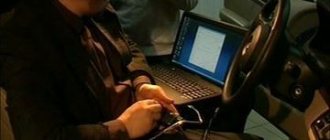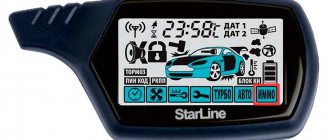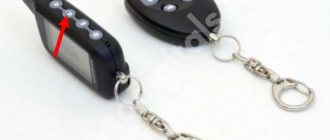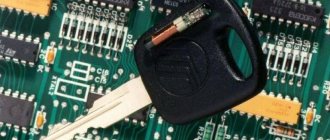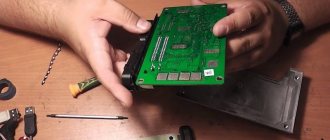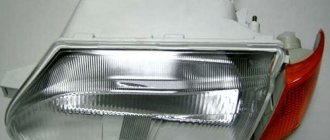Standard anti-theft systems of domestic cars have never been highly reliable. In the “four”, the immobilizer is responsible for protecting the car from theft. This protection system was installed only in injection versions of the VAZ. The essence of the operation of this device is the exchange of signals between the chip in the ignition key and the electronic control unit. If there is no signal, the system will not allow the engine to start and will stop supplying power to it. Over time, this system begins to fail, which at one point makes it impossible to start the engine normally.
Useful video:
In this case, drivers are wondering how to disable the immobilizer on a VAZ 2114. Instructions for dismantling the device are presented below.
We are looking for the “culprit” of all problems
Let's assume that we are talking only about the VAZ-2114 hatchback. If the key, that is, the key fob, needs to be leaned against the platform, disconnect its two connectors (the light bulb and the antenna). And then, taking a screwdriver, you can dismantle the separate block attached to the right of the steering column:
Dismantling the APS module
The unit itself is called APS-4, but in its case, if we talk about the last years of production, APS-6 electronics may be located.
Let's say they are installing an alarm system with auto start, and a standard immobilizer, such as APS-6, has been activated. There are four solutions:
- An immobilizer bypass is connected to the alarm, and a chip key is placed inside the bypass body;
- A good option is to install keyless crawlers, only cars of the 2114 family do not have a CAN bus, and there is nowhere to connect digitally;
- You can also switch the immobilizer to service mode, but in APS-6 modules, unlike APS-4, this feature is blocked;
- Finally, you can get rid of the standard protection completely, but to do this you will need to reset the EEPROM of the ECU.
In general, EEPROM is a “storage device”, and the ECU is the engine controller. It turns out that you will have to work with the controller unit, but the immobilizer itself will remain the same.
Safety Notes
A standard device such as the APS provides the best level of protection. But an alarm system, even the most modern one, can be considered only an additional security device. It does not exchange data with the ECU and does not prevent the engine from starting. At the same time, when installing an alarm system with auto-start, blocking is always implemented. Two cords going to the main unit are connected to the starter cable. And until the security is turned off, you cannot start the engine.
Typical signaling connection diagram
All wiring connected to the ignition switch carries significant current. But doing the installation yourself does not always ensure good quality connections. In general, it is better to entrust the autostart connection to an experienced electrician. We wish you success.
How to disable the alarm along with the immobilizer on VAZ cars
The equipment manufacturer always indicates in the instructions how to turn off the alarm in the absence of a key fob. By pressing the Valet button in a certain sequence, the security mode is deactivated in 100% of cases. It turns out that it will be easy to turn off the car alarm if you know the corresponding code.
But the Valet button is not connected to immobilizers, including standard ones. Therefore, before leaving, you will have to spend 20-30 minutes just to deactivate the protection for a while.
Here we discuss how to independently disable the APS-6 immobilizer, which has been standard equipment on any VAZ car since 2004.
To disable the alarm, you do not need to program anything. Let's say the key fobs are lost - then you open the instructions, look for the secret code and disarm the car by clicking on Valet.
It is possible to program a new code that differs from the standard one, and the programming itself is performed precisely in such cases. But with immobilizers, everything looks the other way around - if the device is not programmed, then in the absence of a correctly registered key fob, only towing will help.
Disabling the immobilizer from the car wiring is not suitable for everyone.
Immobilizer connector, pins 9-18
Writing a code sequence to the immobilizer
It is not discussed here how to disable the APS-6 immobilizer if it has been activated once.
This action is not feasible at all, although disabling the alarm, if we talk about standard equipment, is provided for in VAZ cars.
Let's say the standard immobilizer was not activated and was not used by the owner. Then, 6 seconds after starting the engine, the “light with the car” turns on.
VAZ training and working key
- Take the “working” and “training” keys (with a red stripe).
- You need to close the car doors, install the “learning” key, turn the ignition on and off immediately. The light will start flashing.
- Within 6 seconds, change the key to a “working” one. Turn on the ignition.
- 3 beeps will follow, then a couple more beeps. Then, the ignition is turned off.
- In 6 seconds, change the key again to “learning” and turn on the ignition.
- Proceed similarly to step “4”.
- Keep the key in the lock until you hear a single signal (the LED will change behavior).
- While the LED is flashing, turn on the ignition.
- Wait until the Check Engine light goes off.
- By pressing the “gas” you enter the code. Short press – increase the number, long press (more than 5 seconds) – record. A total of 6 digits are used.
- If you hold the gas for more than 5 seconds, you will notice: the Check Engine does not go off.
- Turn off the ignition.
This concludes the recording.
Bypass using a code sequence
If we were looking at how to turn off a car alarm, it would say: open the car door, close it and press the Valet button in the previously specified sequence.
Gas pedal module with sensors
For APS-6, the gas pedal plays the role of a button. And you set the sequence in question yourself (see the previous chapter). Turn on the ignition using any key and wait until the Check Engine light goes out.
Entering the code is carried out in the same way as indicated in the previous chapter (step 10). There are requirements:
- After entering the 6th decimal digit, the Chech Engine light should be on;
- If your light is blinking, the wrong code was used;
- After the engine starts, the lamp may come on or go out (ECU M1.5.4).
You will start the engine if the Check Engine light remains on after entering the sequence. Have a good start.
Deactivation will continue to operate after the generator is turned on. But the action time will be short - 5 seconds.
Now a lyrical digression. The APS-6 module acts as a signaling device, controlling the standard electrical package:
Modification of the terminal block after disconnection
Here's how to deal with the consequences caused by the lack of an immobilizer:
- In the M1.5.4 ECU unit (Bosch), the standard EEPROM chip is replaced with a service one. Turn on the ignition for a couple of seconds. Those who do not want to open the case can use the COMBISET program.
- For ECU “January 5.1.X”, VS.1, programmer circuits have been developed that allow you to write data to EEPROM without opening the unit. The new firmware file can be downloaded here: https://chiptuner.ru/download/progs/eeprom.zip or read it from a system that has not yet been activated.
- The COMBISET program is suitable for the Bosch MP7.0H unit.
It was discussed how to turn off the alarm on a car if the alarm function is implemented by the APS-6 unit. By the way, another option is suitable for the Bosch MP7.0H ECU - the chip is desoldered in order to flash it “from scratch”.
Internals of the engine control unit
True, to perform these actions you need a programmer.
Polite lighting and door switches
Any alarm or security system is always equipped with an input connected to the door limit switches. In VAZ cars, the control wire can be connected to one point (A). Diodes are not used in this case:
Door control connection diagram
Be sure to carry out the setup: the delay in polling the limit switches should be 20-30 seconds. If this is not done, false alarms will occur when the security system is turned on. The reason is the operation of the APS unit, which does not turn off the light after the driver's door is closed. The option in question is called “polite backlighting.”
There are even modern alarm systems that do not allow delaying sensor polling. Installing diodes will help solve the problem.
In theory, pins 7 and 13 of the BSK are the connection points that need to be decoupled by two diodes. But as practice shows, it is better to implement a circuit with three additional diodes (see figure). The alarm is connected to point B, and setting the polling delay in this case is not required. Good luck.
What to do if the immobilizer has blocked the engine from starting
Unlocking the immobilizer can be done in several ways, much depends on the type of device installed in a particular brand of car.
Common methods:
- Using an infrared transmitter;
- Using the central locking button.
Unlock using IR transmitter
The method, if the immobilizer has blocked the engine, is suitable for types of devices in which the central locking and immobilizer are controlled by an IR key, for example, like in Mercedes cars.
In this case, you will need a four-digit code, which is entered during the unlocking process by pressing the on-board computer button (hereinafter referred to as BC) while holding down the gas pedal. The button is located on the windshield wiper switch at the end (not on all cars).
Algorithm of actions:
- Activate the immobilizer and turn on the ignition;
- A flashing light on the instrument panel will indicate that engine starting is blocked;
- We remove the blinking of the lamp by squeezing the gas pedal;
- Find the BC button. Without releasing the gas pedal, press it as many times as the first digit of the code;
- Take your foot off the pedal and the lamp will start flashing again;
- We press the pedal again - by pressing the BC button we enter the second digit of the code.
- Let's release the pedal;
- We repeat the same steps two more times.
A constant light on the lamp, regardless of whether the gas pedal is depressed or not, will indicate that the immobilizer is unlocked and you can try to start the engine.
If the code was entered incorrectly, the immobilizer will block the engine again. Nothing bad happened, you have two more tries. If they were not successful, then after 15 minutes you can repeat them.
How to unlock using the central locking button
To unlock the immobilizer using the central locking control button, you will need to enter an emergency code.
It is important to understand that using the steps listed below you can only start the car, but not decode the computer and the solenoid valve. Algorithm of actions:. Algorithm of actions:
Algorithm of actions:
Turn on the ignition. The light on the instrument panel will flash slowly. Turn the ignition off and on again. The light will flash faster, other lights will appear and go out after 3 seconds. After pressing and holding the central button on the key fob, the lamp will flash more slowly
Carefully monitor the blinking process, it is important to count the flashes and when their number is equal to the first digit of the code, release the central button on the key fob. Press and hold the button again. Release it as soon as the number of blinks matches the second digit of the code
Repeat this two more times
We release it as soon as the number of blinks matches the second digit of the code. We repeat this two more times.
That's it, the immobilizer is unlocked and you can start the engine. But when the ignition is on, a lamp flashing every 3 seconds will indicate that the protection is disabled.
The immobilizer will be locked again, after which you will have to enter the code again if:
- You turn off the ignition for more than 10 seconds.
- Disconnect the battery.
- The device will be blocked for 5 minutes if the code is entered 3 times in a row with an error.
How to turn off car alarms with your own hands?
Before completely disabling the security installation on a non-traveling vehicle, read the recommendations for entering a password. This is especially true if you use a complex car alarm system with a GSM module.
Depending on the manufacturer and model of the car alarm, the unlocking process may vary. Let's consider several options.
Sheriff
Unlocking the “Sheriff” alarm is done in this way:
- Using the key, unlock the car door locks.
- The ignition is activated.
- The service key is pressed once.
- The ignition is deactivated and reactivated.
- The emergency mode key Valet is pressed.
User ardent talked about how to properly reflash Sheriff alarm control panels to further turn off the siren.
Alligator
Depending on the alarm model, the deactivation procedure may differ.
The D-810 model can be turned off in two ways - emergency shutdown or standard.
- The car doors must be unlocked using the key; sit in the driver's seat.
- Activate the ignition.
- The driver must press the Valet button once within 15 seconds.
- The ignition is deactivated.
These steps will not activate emergency mode. This means that if the option of passive activation of protection is enabled, then after the next deactivation of the ignition and closing of the doors, the protection will be activated again. You can try to put the “alarm” into emergency mode by entering a code that is set by the car owner or installation specialist.
How to unlock:
- Car doors are opened using a key.
- The ignition is activated.
- Then it must be deactivated and reactivated.
- Within fifteen seconds, the car owner must have time to press the Valet button the number of times corresponding to the first digit of the code.
- The key is turned off and turned to ignition mode.
- In ten seconds, the driver presses Valet as many times as the PIN number should be.
- The ignition is then deactivated and turned on again. The input process is repeated as many times as there are digits in the password, but not more than four. If the procedure is completed correctly, the service option is activated.
User Karabas Barabasovich diagnosed the Alligator alarm system at the stand and spoke about the malfunctions that the car owner will encounter.
How to disable the immobilizer on a VAZ-2114
Disabling the immobilizer on a VAZ-2114 may be necessary in several cases:
- there is a need for a more advanced anti-theft system (for example, equipped with auto start);
- if the immobilizer is full of “software junk,” the control unit fails;
- the car has a device with an anti-theft function that has a manufacturing defect;
- the blocking system generates an error as a result of the battery being completely discharged;
- There was a sudden blocking of the standard anti-theft system.
There are several ways in which you can disable the immobilizer on a VAZ-2114 without any problems.
The first method is to physically disable the immobilizer. To do this, we perform several simple steps:
- remove the connector from this anti-theft device;
- We put a jumper for diagnostics.
The second method is to take the engine control unit to a service center or go there by car, and qualified specialists will deal with the control unit. Typically, disabling the standard anti-theft system takes about fifteen minutes.
The third method is to disable the control unit on the immobilizer yourself. To do this, you should follow these instructions:
- Find the electronic control unit (ECU) of the anti-theft device (it may be located inside the center console).
- Remove the signal wire connector from the ECU.
- Count the ninth and eighteenth contacts (out of twenty available).
- Cut off the ninth and eighteenth contacts of the wiring - from the block at a distance of four to five centimeters.
- Strip the ends of the cut contact wires.
- Twist the ends of the cut wires.
- Insulate the twisted ends of the wires (this action will restore the diagnostic line, and the immobilizer will stop transmitting its data to the electronic control unit).
- Reinstall the connectors in their original places.
This method is simple even for a novice car enthusiast, but it cannot always correctly disable the standard anti-theft device.
The fourth method is to reflash the electronic control unit of the standard immobilizer on the VAZ-2114. Of course, it is best to entrust such an operation to qualified specialists from the service center. But if the vehicle owner does not have such an opportunity, then you can try to reflash the anti-theft device ECU yourself at home. The term “reflash” itself means erasing all information about this device from the memory of the electronic control unit. To do this you need to prepare the following tools:
- special software;
- computer;
- soldering gun or soldering station;
- microcircuit programmer.
After we have prepared the necessary tools, we move on to specific actions:
- We dismantle the electronic engine control unit, to which the standard immobilizer from the passenger car is connected.
- Open the back cover of the ECU.
- We find the required microcircuit that is responsible for the registered data about the anti-theft device (you can read about what kind of circuit this is in the corresponding instructions for the device).
- We unsolder the old microcircuit.
- Choose one of the options for the next step:
- or solder in a new microcircuit;
- or we clean an existing microcircuit using a Windows computer and a special program for resetting the memory of microcircuits.
- We physically disable the immobilizer so that the ECU memory does not record new information about it.
- We install the re-flashed electronic control unit on the car again.
This method is more painstaking, but it is distinguished by its effectiveness. But this only completed the immobilizer flashing operation; it will still need to be reprogrammed using a “learning” red key. And only after this can you officially disable the standard anti-theft device.
Experts recommend paying attention to several nuances:
- When the standard anti-theft system is disabled, the vehicle becomes accessible to criminal thefts.
- The ECU system of a car engine is quite complex, so independent intervention in its programs, such as flashing microcircuits, can lead to irreversible consequences.
If you are not confident in your abilities and knowledge, experts do not advise opening and reprogramming the electronic control unit yourself, but contacting a car service center.
Materials: https://ladaautos.ru/vaz-2114/kak-samomu-otklyuchit-immobilajzer-na-vaz-2114.html
Disconnection Guide
Do I need to turn off the immo or alarm and how to do it correctly? We invite you to take a closer look at these issues.
Is it necessary to disable the immobilizer on the fourteenth VAZ model?
If there is a need, then of course it is necessary. The need to turn off the alarm or immobilizer arises in cases where the system blocks engine operation and starting the power unit becomes impossible.
How to disable?
If we are talking about signaling, then first of all you need to know about the connection points that were used during installation. Every anti-theft system has an emergency stop button, usually called the Valet service button. It doesn’t matter whether it’s a European emergency warning button for a VAZ 2114, a new model or an old one.
The combination with the use of Euro emergency lights in the event of the anti-theft system being disabled is described in the operating manual. This process is individual for each individual signaling model, so we will not describe it. If the emergency lights on the “four” do not work, then you will have to turn off the central unit, but you cannot do without the help of a professional in this matter.
As for how to properly disable immo with your own hands, the procedure is as follows:
- First you need to find the block of the installed anti-theft system. If you installed the immobilizer yourself, you should know where the control module is located. If the installation is installed from the factory, then the module should be located inside the dashboard, directly under the steering wheel.
- Next, you need to disconnect the connector with the signal wires from the control module. Disconnect the wires and move them aside.
- Now you will need to find pins numbered 9 and 18, for a total of 20 pins on the connector.
- Contacts numbered 9 and 18 must be cut using a utility knife. Strip the contacts of the cut wires, then twist them as securely as possible and insulate them. Use electrical tape to insulate the section. By completing these steps, you can restore the K-Line diagnostic line, which will allow you to monitor the condition of the main systems and components of the vehicle.
- Next, reinstall the connector. This way you can disable the anti-theft system and start the engine. This method is the simplest, but it must be borne in mind that it does not guarantee the correct disabling of the anti-theft system.
Types of devices
Any immobilizer, not only from VAZ, has its purpose. This device must create conditions under which the movement of the car and any manipulations with it automatically become impossible if someone tries to gain unauthorized access to the car. Okay, isn't it? Someone gets into your VAZ 2114, tries to move away, but it doesn’t move and shows no signs of life at all.
In general, you understand the essence of the immobilizer device. The great advantage of just such a device is that its electrical unit can be placed in the most unpredictable place and the thief will break his head a thousand times, but will not be able to turn it off.
Immobilizer VAZ 2114
Based on the principle of operation, there may also be various types of immobilizer devices from the VAZ plant. Some ensure complete immobility of the car when you are simply not around your 2114. In this case, the hijacker, having climbed inside, simply will not be able to do anything. Another option is when the immobilizer allows the thief to sit comfortably in the car, even drive a little, but at the most necessary moment the car simply stops rooted to the spot. An inexperienced thief may think that something is simply broken in the car and abandon his attempt to steal it. If he turns out to be experienced and understands what happened, then there will be no miracle here either - no one will look for the control unit in the middle of the street and he will have to leave.
Also very interesting are the methods of operation of such devices; they come in the following types:
- Contact.
- Contactless.
It is this fact that is decisive when determining the price of the device. Now let's figure out how this whole thing works. In the contact arrangement, the trigger for the car locking is the fact that they tried to start the engine with a non-original unique key or without any key at all. Of course, for the VAZ 2114 they will not make an individual key for each car, the lock simply knows certain features of the particular key model that it has and will allow it to start the engine using another one.
Another method, contactless, is much more promising. Here everything is more complicated - the car is in working condition and the immobilizer does not block any of the car systems as long as the key with its unique chip is within a few meters from the car. That is, in the car unit there is a radio receiver that records a unique code that is emitted by the chip in the key and the car seems to feel that the owner is here and is behaving completely calmly. As soon as the key leaves the signal range, the car immediately understands that it is in protected mode. So, no one will definitely steal your VAZ 2114.
Immobilizer VAZ 2114
Engine blocking with car alarm
If there are installed anti-theft systems, electrical equipment is responsible for blocking the engine start. Immobilizers or car alarms may turn out to be faulty and give constant or isolated failures during operation.
It should be added that the severity of the problem will depend not on a specific model or brand of car, but on the complexity of the installed anti-theft system.
Why does the starter turn normally, but the engine does not catch and does not start? The main reasons for the malfunction, checking the fuel supply and ignition systems. Adviсe.
Accidental activation of the engine lock function
First, carefully study the displayed icons on the alarm key fob. A common reason for blocking is the accidental activation of additional functions. You also need to monitor the LED readings (if present) in the car interior, which serves as a light indicator of the alarm status. The flickering of the LED lamp almost always indicates that the anti-theft function of the immobilizer is activated in the menu.
What is an immobilizer
If you buy a decent car, the manufacturer has already equipped it with protection in the form of an immobilizer. This is the most common and effective means in the fight against car theft.
In simple terms, the immobilizer prevents all kinds of attempts to start the car if a key containing a unique chip has not been inserted into the lock. Even if you insert a “blank” key into the lock, the device will see that there is no chip and refuse to start the engine.
When you turn on the ignition and the lights on the dashboard come on and then go off, at the same moment the immobilizer reads the code from the chip, and if it is correct, it allows you to start the engine. If the chip is incorrect, the immobilizer blocks all ways to move away, except with the help of a tow.
Many car enthusiasts, after purchasing a car, express a desire to increase the security of their car and install an alarm. However, if you have a car with an immobilizer, this can be a little problematic.
Immobilizer functions on the VAZ-2114
VAZ-2114 automakers consider it their duty to install an anti-theft system, called a standard immobilizer, on every vehicle they produce. This device communicates with the engine (with its injection controller) using certain programs. Thanks to the program, an enabling signal is sent to the controller, which does not independently initiate the engine start. That is, the program of the built-in anti-theft device blocks the start of the engine.
The mechanism of operation of the immobilizer is to break the connection of the vehicle's electrical circuit in one of the significant places. This location may be the ignition or starter electrical circuit. Due to the rupture, the car will not start and will remain stationary. The calculation is that if a thief wants to steal a car, it will be protected by an immobilizer program that will prevent the engine from starting.
So that the owner of the VAZ-2114 can control the standard anti-theft system, electronic code keys are attached to it. According to the instructions, the car driver must use the electronic code key in the following way:
- insert it into a special socket (for a contact type of device) or bring it to the system status indicator - ISS (for a contactless type of device);
- The immobilizer system reads the key program code;
- The vehicle lock will be disabled.
They differ in standard colors:
- worker – black;
- educational - red.
Initially, you should carry out a training procedure for the anti-theft system so that the immobilizer is triggered by a working key, since the new car is in an inactive state. It can only be activated using the red “learning” key. As soon as this happens, the functions of enabling and disabling the anti-theft device will transfer to the working “black” key. Thus, a standard immobilizer is intended to protect the vehicle from unauthorized engine starting. The offender, even after climbing into the car, may try to start its engine. But he won’t be able to go anywhere because the immobilizer system in the VAZ-2114 will block the engine.
IF A BOSCH MP7.0 CONTROLLER IS INSTALLED
Training the “bypass password”:
1. The anti-theft system is armed. Prepare a six-digit password with which you want to train the system. Each digit can be from 1 to 9. 2. Turn on the ignition. The “Check Engine” (CE) lamp on the instrument cluster will illuminate continuously. The system status indicator LED will flash 2 times per second. 3. Bring “your” red key to the system status indicator and hold it, turn off the ignition. The LED will light up continuously and the buzzer will emit a short beep. Remove the key from the indicator. 4. 3...5 seconds after the ignition is turned off, the indicator LED will start blinking at a frequency of 10 times per second. 5. No later than 10 seconds after the LED starts blinking, turn on the car’s ignition, the CE lamp will blink once per second, which indicates entering the “bypass password” input mode. 6. Wait 4 minutes for the CE lamp to flash, then the lamp turns off for 1 minute. During this time, enter the first digit of the password by pressing the accelerator pedal all the way. You need to press as many times as the first digit of the entered password. Each time you press the pedal, the CE lamp comes on. After a minute has passed, the lamp resumes flashing again for another 4 minutes. 7. Wait 4 minutes until the CE lamp flashes, then repeat the number entry procedure for the second digit of the password and so on until the last sixth digit of the password is entered. If any number is not entered, then after 1 minute the lamp will begin to flash at a frequency of 1.5 times per second. You must turn off the ignition for at least 15 seconds, then start learning again. If all numbers are entered correctly, then after the last minute the CE lamp will no longer turn on. 8. Turn off the ignition for at least 15 seconds.
ATTENTION!
1. The entered bypass password has no restrictions on its use, i.e. Once programmed, the password can be used many times.
2. If the password is not entered completely, it is not remembered.
3. If you want to prohibit the procedure for alternative engine starting programmed earlier, then you should:
— repeat steps 1...5, but in step 6 do not press the accelerator pedal. After 1 minute has elapsed for entering the first digit of the password, the CE lamp will begin to flash at a frequency of 1.5 times per second. Turn off the ignition for at least 20 seconds. The previously programmed password will be erased.
Manipulations with the ECU controller
The VAZ-2114 controller unit may belong to the following family - January 5.1.X or ITELMA 5.1. The digital designation printed on the label in this case looks like this: 2111-1411020-71 (the numbers “72” may appear). If the last two digits are a “space” or the number “70,” it means that the BOSCH M1.5.4 controller is installed. In the latter case, erasing the EEPROM involves disassembling the block, but without soldering. And in the first case, you don’t even have to open the block cover.
Resetting EEPROM in a BOSCH controller
Let's see what the controller board looks like from below:
The 24C02 chip is the EEPROM memory. Circle the 5th and 6th taps, B and C, with a marker. These points are intended for connecting the programmer, which is assembled from three transistors.
The programmer circuit in question looks trivial. This means you can quickly assemble it with your own hands:
Programmer for EEPROM 24C02
The device is connected to the COM port of the computer. And the voltage “12 Volts” is taken from the MOLEX connector. Of course, ground must also be taken from this connector. The maximum current consumed by the ECU will in any case not exceed 0.5 A.
Now let’s look at the procedure for allowing the ECU to “forget” about the existence of the immobilizer:
The 18th and 27th contacts of the block are supplied with supply voltage (12 Volts);
The common wire, that is, ground, is connected to pin 19;
Connect contact B of the programmer to tap 5;
Connect contact C of the programmer to tap 6;
In the Combiset program interface, select the “Clear EEPROM” item, press the “Install” button;
They wait a few minutes.
The wiring of the main ECU connector looks like this:
ECU block, 55 pins
The Combiset application must be downloaded from the official website (almisoft.ru). Even the Demo version, available in the Download section, is suitable.
In the program itself, you must correctly set the number of the COM port that will be used. The COM-1 port is shown below, but this is not the only option.
Combiset program interface
How “January” controllers are “untied”
A common type of controller in VAZ-2114 cars are the following blocks: January 5.1.X and ITELMA 5.1. They need to be programmed the same way. You need to use an adapter from the COM port to K-Line, but you can easily make it yourself:
Adapter and ECU connection diagram
The homemade adapter operates at a speed of 38 Kbps. Select this value in the Flashecu program (www.nppnts.ru).
The procedure for clearing EEPROM will be as follows:
Make all connections according to the diagram;
Close the contacts of switch S1;
Wait 5 seconds;
Operate switch S2;
In the program interface, click the “Clear EEPROM” button.
The ECU connector diagram is shown in the previous chapter. It is the same for all VAZ ECUs equipped with 55 terminals. The program interface, in turn, looks like this:
Screenshot of the Flashecu program window
The erasing procedure takes several minutes.
General advice for everyone
The block itself, which was mentioned above and which needs to be “untied” from the immobilizer, is always located in one place - under the tunnel cover on the right:
Interior of the fourteenth model
Of course, we are talking about the 2114 family, and in other VAZ cars the unit will be more difficult to find. Installation and disconnection can be done as follows:
Remove the negative terminal from the battery;
Unscrew the fixing bolt and remove the clamp together with the block;
During installation, the steps are carried out in reverse order. But there is one trick.
After connecting the ECU, power is supplied to the network. And then, oddly enough, you need to turn on the ignition and wait for the Check lamp to come on. And only then, turning off the ignition, can you continue operation.
Note that the immobilizer itself, after flashing the unit, should not even come into contact with the latter. Therefore, having disconnected its terminal block from the immobilizer, they carry out the standard modification:
The wires are cut off from terminals 9 and 18;
The resulting branches coming from the loop side are connected.
You don’t have to change anything, but simply disconnect the connector completely, losing some features:
PTF rear headlight control;
As you can see, the immobilizer in modern VAZ cars has many functions. And they turn it off for one purpose - to activate the alarm system with auto start.
Double-row connector for standard immobilizer
The immobilizer bypass module in any VAZ car works well in one case - when it is connected to a break in the antenna circuit. But not all factory-produced modules are designed for this connection option in principle.
APS-6
The APS-4 block is installed on VAZs newer than 2004. These include Priors, Chevrolet Nivas, Kalinas, and Grants. Structurally, the immo differs significantly from the APS-4. The APS-6 has a built-in interior lighting control module (polite lighting, smooth light switching), control of rear fog lights and a power window control module. Also, the new immo can be controlled and diagnosed via k-line. The reader of the APS-6 block is built into the ignition switch (as in foreign cars), and the chip is located directly in the key. Externally, the blocks are identical, sometimes even APS-6 was placed in the housing from APS-4.
Here in the photo is an APS-6 block from the field along with the ECU.
Just like APS-4, cars with immo APS-6 are supplied with the immobilizer disabled. To activate immo you need to do the following.
Fill your car with at least 10 liters of gasoline so as not to get confused by squeaks.
• Collect the black key. • Close the doors. • Turn on the ignition with the RED key. • 3 squeaks. Pull out the key. • Quickly (within 5-6 seconds) turn on the ignition BLACK. • 3 squeaks + 2 squeaks. • Quickly (within 5-6 seconds) turn on the ignition RED • 3 beeps + 2 beeps. • Turn off the ignition KEY IN THE LOCK. • 1 squeak. • Quickly (within 5-6 seconds) turn on the ignition for 5 SECONDS! (Attention! Be sure to wait for the beep signal - there is an ambush in this place). • The emergency lights flashed, the signal beeped • Turn off the ignition. KEY IN THE LOCK until the machine goes out on the panel.
Also in the APS-6 block, the vehicle start locks have been changed. If APS-4 turned off the fuel pump and spark, then APS-6 turns off only the injectors. The matter is related to the environment - the car should not emit gasoline into the atmosphere through the exhaust pipe. Although this is not only about ecology, even about safety. If the car pours gasoline into the exhaust, then when you first start it, it might make a big bang. Well, the catalyst really doesn’t like gasoline.
Whether or not to activate the standard immobilizer on a VAZ - let everyone decide for themselves. I definitely wouldn’t do this if the car is equipped with an APS-4 immobilizer. The fact that the car will not be stolen is a controversial option; if they want to steal it, they will come with their own ECU and a standard immo will not help here. As they already told me in the comments, the immo is used to prevent the punks from starting the car with their bare hands.
But I would activate APS-6, especially on new cars (Grant, Shniva, Priora).
Well, a few more words about diagnosing a car with an immobilizer. In some cases, a car with an immobilizer does not communicate. The fact is that the K-Line wire from the diagnostic connector goes to the immobilizer, and only after it goes to the ECU. If the car does not communicate, then you need to check whether the immobilizer is connected to its connector. If yes, then you can try to turn it off and close contacts 9 and 18. Thus, the K-line from the diagnostic connector is now connected directly to the ECU.
That's all, thank you for your attention.
Main problems and features of immobilizers
Immo can only interact with the ECU, so this anti-theft device is not used in carburetor cars. Immo exchanges information with the control module and, if necessary, prohibits the device from sending signals to certain nodes. This device makes the appropriate conclusions based on the code that is located in the master key chip. When the key falls within the range of the immo, the chip transmits an encrypted signal to the device, which processes it and gives instructions regarding starting the engine or prohibiting it.
- Since the anti-theft device interacts with the control unit via a diagnostic line, its operation may be impaired as a result of incorrect diagnosis.
- Various interference that even a mobile gadget can produce. Interference is usually caused by more powerful equipment and stations, but even a smartphone can be the cause.
- A manufacturing defect, due to which the device’s circuitry has “glitched” and can no longer function. As practice has shown, defective systems were often found in the first cars that were equipped with immobilizers and injection engines. In this case, the cause of the malfunction is solved either by repairing or replacing the device.
- Also, immo, like the alarm system, may stop working due to a dead car battery. This problem often manifests itself especially in winter, when batteries are more susceptible to discharge as a result of exposure of the electrolyte to low temperatures. In particular, this is true for old batteries that have already reached the end of their service life. In such cases, car owners are required to know how to turn off the alarm or immo.
- Another reason why the immo may stop functioning is a software error. Problems of this kind can be solved by qualified diagnosticians, because there is a possibility that you will have to reflash the control unit (the author of the video about the malfunction of the anti-theft system is the IZO channel))) LENTA).
Why do you have to disable the immobilizer?
VAZ began to equip immo only with injection-type cars. The first anti-theft devices of this series appeared on the VAZ 2110 and they were called APS-4. Today, more modern APS-6 models are more common. Now all cars of the 2110 to 2115 series are equipped with this particular device.
The most common problem with this device is the loss of the key or if the car owner, without knowing it, erased its code. Speaking specifically about VAZ standard immos, you can more often encounter a problem related to the fact that the lights in the cabin do not go out and, as a result, the alarm does not go off. In addition, malfunctions of the immobilizer software often occur, as a result of which its central unit does not read information about the key or considers it “not native”. As a result, when you stop to refuel, you risk being left in a stalled car.
To reprogram (marry, bypass, flash, upgrade, adapt) a device, you must first turn it off. In addition, immobilizers are usually disabled when installing a car alarm.
Where is the immobilizer on the VAZ-2114: photo of where it is located
The purpose of the immobilizer is to prevent any unauthorized attempts to gain access to control the vehicle. The place where the immobilizer is located on the VAZ-2114 is located in the instrument panel, on the ignition switch side, above the engine control unit.
Location of the immobilizer on the VAZ-2114
Location of the APS-4 immobilizer on the car
The fact is that the Togliatti designers who created the “four” mocked the consumer by installing an ECU and an immobilizer under the pipes of the car’s heater system. Thus, if the tightness of the system is broken, they must be filled with antifreeze.
What is an immobilizer and why is it criticized?
Since the beginning of the 2000s, an automobile anti-theft system (APS) has been installed on all injection engines produced in Tolyatti.
Initially, the first “tens” were equipped with APS-4, but they were soon replaced by more modern APS-6.
The standard anti-theft system is otherwise called an immobilizer.
The meaning of the system is as follows: an attempt to steal a car will end in nothing. The attacker will not be able to start the engine, and if he does start it, then after driving a few hundred meters the fuel supply will stop and the engine will stall.
The idea is good, but there are a number of problems that arise during its operation:
- Software failure. The electronics does not see the update of information supplied by the ignition key or does not recognize it. There were cases when, having stopped and turned off the engine, it was no longer possible to start it.
- Engine blocking due to low battery. Leaving your car in a parking lot for several days in winter can accidentally activate the system.
- Serious problems when connecting an alarm system with auto start.
- Breakdown, short circuit of contacts due to poor location.
Interesting! The first injection VAZ-2114 were produced either without APS, or with an unconnected unit dangling inside on its own wiring. Nobody knows what this was due to (savings, lack of equipment or another reason), but the fact remains.
Troubleshooting
In the case when a car with an active immobilizer does not communicate with the computer, you need to know the following: the K-Line wire connects the diagnostic connector and the APS. Only then does the power enter the electronic control unit.
In the event of a malfunction, you need to make sure that the system is connected to the correct connector. If the result is positive, you can try to disconnect it and bridge the 9th and 18th contacts.
This will result in a direct connection between the ECU and the diagnostic connector, bypassing the anti-theft system.
In case of malfunctions related to the operation of the immobilizer, it is necessary to take into account the fact that this is a complex electronic device. Therefore, to troubleshoot it, it is recommended to contact a professional auto electrician.
Important! In the event of breakdowns associated with its operation, you need to know that restoring functioning after the intervention of incompetent hands can be difficult, and in some cases completely impossible.
Deactivation and activation (pros and cons)
The Bosch ECU on the VAZ-2114 came complete with an APS-4 immoblizer
When deciding whether to deactivate the immobilizer or not, you need to know the following. APS-6 or 4, although it has a number of significant drawbacks, it really counteracts hooligans who may decide to ride in a car parked near the entrance. The alarm does not turn off the engine and fuel system.
The anti-theft system of the 6th series, on the contrary, turns off the power to the fuel injectors (the 4th turns off the fuel pump and glow plugs). Therefore, it’s up to you to decide whether to connect it after the next glitch or not. But at least, if they decide to steal a car, then they will need their own ECU; you can’t take the car with your bare hands.
Let's start with APS-4
APS-4 was installed on early VAZs sometime before 2007. Tens, chisels, etc. Works with MP7.0, M1.5.4 (Bosch) and January-5 ECUs. NOT installed on priors, viburnums, shnivy. They had APS-6, read about it below. I didn’t install it on classics at all.
One of the design features is that the immo key is not located in the ignition key, but on a separate key fob, which must be brought to a special place on the panel to be read. By the way, there are quite a few articles on the Internet where people remade this key fob and built it into the key, rewinding the antenna to the ignition switch.
This is what the APS-4 and keychains for it look like:
Immo began to be installed on VAZs from the moment the production of injection cars began, but there was a small lapse: when they started making injectors, it turned out that there weren’t enough immobilizers for everyone.
I don't know why this happened. Either the plant couldn’t cope, or they were saving money, but among the first cars there were cars both equipped with an immobilizer and without it, although all the wiring for it was there - only the unit itself was missing. Because of this, a dilemma arose - what to do?
The solution was ingenious - they decided to supply cars with an immoblizer, but not included in the car's ECU. That is, the box simply dangled in the wiring until the new owner decided to activate it. Accordingly, if there was no immo, there were no problems.
Here is an example of how to activate the immobilizer, taken from the instructions for the APS-4 unit:
• Turn on the ignition, the APS LED lights up • Bring the red key • Turn off the ignition without removing the red key. • Short squeak. The APS LED should start flashing. • Bring 1 black key. • Squeak. The LED goes out temporarily. • Bring 2 black keys. • Squeak. The LED goes out temporarily. • Bring the red key. • Squeak. The LED lights up. • Turn on the ignition. • Squeak. The LED goes out. (On MP7.0 the LED continues to light. You must turn off the ignition no later than after 10 seconds.) • Turn off the ignition.
After activating the immobilizer, a code was written into the memory of the car's ECU and then worked with it. I note that the ECU, having not received the go-ahead to start from the immo, turned off not the injectors, but the fuel pump and ignition control. The next mistake was that if you put the brains from a car with an activated immo on a car with an activated immo, the car will start...
If anyone wants to know whether their immobilizer is activated, here is an excerpt from the manual (applies only to APS-4): The immobilizer training procedure is the responsibility of dealers, but unfortunately, not all of them carry out this procedure. Therefore, for further actions it is necessary to be able to determine whether the immobilizer is clean or trained.
This can be determined by the time the LED turns on in the standby state. The immobilizer is in the standby state (ignition is turned off, the driver's door is closed) after the interior lighting goes out. In this state, the LED flashes once every 2.5 seconds, but if the immobilizer is clean, then the time the LED is on is 0.5 seconds, and if it is trained - 0.1 seconds.
The most hemorrhoids were APS-4 until 2001, in which noise immunity was slightly better than none. The immobilizer keys could fly off when the scanner is connected when the ignition is on, due to strong interference from a mobile phone. Also, the units often forgot the keys after the battery was discharged, after lighting another car, etc. The unfortunate repairmen who simply changed the brains of the car made good money from this. The issue of disabling the immobilizer will not be discussed in this article. After 2001, noise immunity was increased and problems with immobilizers became significantly less. I think that about APS-4 will be enough. If you have any questions, ask them in the comments.

